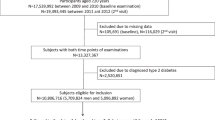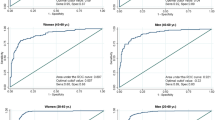Abstract
Background/Objectives:
To determine which component of the metabolic syndrome (MetS) is the best predictor of its development.
Subjects/Methods:
In this cohort study, 2279 subjects aged 20–87 years without MetS selected from among the participants of the cross-sectional phase of the Tehran Lipid and Glucose Study (TLGS) were followed up for development of MetS.
Results:
After a mean interval of 6.5 years, 462 and 602 new cases of MetS were diagnosed on the basis of the modified Adult Treatment Panel III (ATP III) and International Diabetes Federation (IDF) criteria, respectively. The adjusted odds ratio for development of MetS by ATP III criteria was highest for central obesity in men, 2.8 (2.2–3.7), and for triglycerides (TGs) in women, 2.8 (2.0–4.1). The adjusted odds ratio for the development of MetS by IDF criteria was highest for TGs in both men and women: odds ratio 2.8 (2.2–3.7) and 2.9 (1.9–4.3), respectively. A model that included waist circumference (WC) and TGs or WC and high-density lipoprotein (HDL) predicted MetS similar to a model that included all five MetS components.
Conclusion:
Screening for the timely prediction of the development of MetS should include measurement of WC, TGs and plasma HDL.
This is a preview of subscription content, access via your institution
Access options
Subscribe to this journal
Receive 12 print issues and online access
$259.00 per year
only $21.58 per issue
Buy this article
- Purchase on Springer Link
- Instant access to full article PDF
Prices may be subject to local taxes which are calculated during checkout


Similar content being viewed by others
References
Alberti KG, Zimmet P (1998). Definition, diagnosis and classification of diabetes mellitus and its complications. Part 1: diagnosis and classification of diabetes mellitus provisional report of a WHO consultation. Diabet Med 15, 539–553.
Alberti KG, Zimmet P, Shaw J (2005). The metabolic syndrome- a new worldwide definition. Lancet 366, 1059–1062.
Anisworth BE, Jacobs DR, Leon AS (1993). Validity and reliability of self-reported physical activity status: the Lipid Research Clinics questionnaire. Med Sci Sports Exerc 25, 92–98.
Azizi F, Rahmani M, Emami H, Madjid M (2000). Tehran Lipid and Glucose Study: rational and design. CVD Prev 3, 242–247.
Azizi F, Raiszadeh F, Salehi P, Rahmani M, Emami H, Ghanbarian A et al. (2002). Determinants of serum HDL-C level in Tehran urban population: Tehran Lipid and Glucose Study. Nutr Metab Cardiovasc Dis 12, 80–89.
Bahrami H, Sadatsafavi M, Pourshams A, Kamangar F, Nouraei M, Semnani S et al. (2006). Obesity and hypertension in an Iranian cohort study; Iranian women experience higher rates of obesity and hypertension than American women. BMC Public Health 6, 158.
Balkau B, Charles MA (1999). Comment on the provisional report from the WHO consultation. European Group for the Study of Insulin Resistance (EGIR). Diabet Med 16, 442–443.
Bloomgarden ZT (2003). American Association of Clinical Endocrinologists (AACE) Consensus Conference on the insulin resistance syndrome. Diabetes Care 26, 933–939.
Boyko EJ, Leonetti DL, Bergstrom RW, Newell Morris L, Fujimoto WY (1995). Visceral adiposity, fasting plasma insulin, and blood pressure in Japanese-Americans. Diabetes Care 18, 174–181.
Cheung BM, Wat NM, Tam S, Thomas GN, Leung GM, Cheng CH et al. (2008). Components of the metabolic syndrome predictive of its development: a 6-year longitudinal study in Hong Kong Chinese. Clin Endocrinol (Oxf) 68, 730–737.
Davis M (1999). New diagnostic criteria for diabetes: are they doing what they should? Lancet 354, 610–611.
DeLong ER, DeLong DM, Clarke-Pearson DL (1988). Comparing the areas under two or more correlated receiver operating characteristic curves: a nonparametric approach. Biometrics 44, 837–845.
Esteghamati AR, Gouya MM, Abbasi M, Delavari AR, Alikhani S, Alaedini F et al. (2008). Prevalence of diabetes and impaired fasting glucose in the adult population of Iran: national survey of risk factors for non-communicable diseases of Iran. Diabetes Care 1, 96–98.
Expert Panel on Detection, Evaluation, Treatment of High Blood Cholesterol in Adults (2001). Executive summary of the third report of the National Cholesterol Education Program (NCEP) expert panel on detection, evaluation, and treatment of high blood cholesterol in adults (Adult Treatment Panel III). JAMA 285, 2486–2497.
Ford ES (2005). Risks for all-cause mortality, cardiovascular disease, and diabetes associated with the metabolic syndrome. A summary of the evidence. Diabetes Care 28, 1769–1778.
Gami AS, Witt BJ, Howard DE, Erwin PJ, Gami LA, Somers VK et al. (2007). Metabolic syndrome and risk of incident cardiovascular events and death: a systematic review and meta-analysis of longitudinal studies. Am Coll Cardiol 49, 403–414.
Ghassemi H, Harrison G, Mohammad K (2005). An accelerated nutrition transition in Iran. Public Health Nutr 5, 149–155.
Grundy SM, Cleeman JI, Daniels SR, Donato KA, EcKel RH, Franklin BA et al. (2005). Diagnosis and Management of the metabolic syndrome. An American heart Association/National Heart, Lung, and Blood Institute Scientific statement. Circulation 112, 2735–2752.
Han TS, Richmond P, Avenell A, Lean ME (1997). Waist circumference reduction and cardiovascular benefits during weight loss in women. Int J Obes Relat Metab Disord 21, 127–134.
Hatmi ZN, Tahvildari S, Gafarzadeh Motlag A, Sabouri Kashani A (2007). Prevalence of coronary artery disease risk factors in Iran: a population based survey. BMC Cardiovasc Disord 7, 32.
Janssen I, Katzmarzyk PT, Ross R (2004). Waist circumference and not body mass index explains obesity related health risk. Am J Clin Nutr 79, 379–384.
Laaksonen DE, Lakka HM, Niskanen LK, Kaplan GA, Salonen JT, Lakka TA et al. (2002). Metabolic syndrome and development of diabetes mellitus: application and validation of recently suggested definitions of the metabolic syndrome in a prospective cohort study. Am J Epidemiol 156, 1070–1077.
Lorenzo C, Serrano-Rios M, Martinez-Larrad MT (2003). Central adiposity determines prevalence of the metabolic syndrome. Obes Res 11, 1480–1487.
Palaniappan L, Carnethon MR, Wang Y, Hanley AJ, Fortmann SP, Haffner SM et al. (2004). Insulin resistance. Atherosclerosis study predictors of the incident metabolic syndrome in adults: the insulin resistance atherosclerosis study. Diabetes Care 27, 788–793.
Pouliot MC, Després JP, Lemieux S, Moorjani S, Bouchard C, Tremblay A et al. (1994). Waist circumference and abdominal sagittal diameter: best simple anthropometric indexes of abdominal visceral adipose tissue accumulation and related cardiovascular risk in men and women. Am J Cardiol 73, 460–468.
Reaven GM, Lithell H, Landsberg L (1996). Hypertension and associated metabolic abnormalities- the role of insulin resistance and the sympathoadrenal system. N Engl J Med 334, 374–381.
Sheikholeslam R, Mohammad A, Mohammad K, Vaseghi S (2004). Non-communicable disease risk factors in Iran. Asia Pac J Clin Nutr 13 (Suppl), S100.
Sheu WH, Chuang SY, Lee WJ, Tsai ST, Chou P, Chen CH et al. (2006). Predictors of incident diabetes, metabolic syndrome in middle-aged adults: a 10-year follow-up study from Kinmen, Taiwan. Diabetes Res Clin Pract 74, 162–168.
Wang Y, Rimm EB, Stampfer MJ, Willett WC, Hu FB (2005). Comparison of abdominal adiposity and overall obesity in predicting risk of type 2 diabetes among men. Am J Clin Nutr 81, 555–563.
Zabetian A, Hadaegh F, Azizi F (2007). Prevalence of metabolic syndrome in Iranian adult population, concordance between the IDF with the ATPIII and the WHO definitions. Diabetes Res Clin Pract 77, 251–257.
Acknowledgements
This study was supported by Grant number 121 from the National Research Council of the Islamic Republic of Iran and by the combined support of the National Research Council of Islamic Republic of Iran and Endocrine Research Center of Shahid Beheshti University of Medical Sciences.
Author information
Authors and Affiliations
Corresponding author
Ethics declarations
Competing interests
The authors declare no conflict of interest.
Rights and permissions
About this article
Cite this article
Heidari, Z., Hosseinpanah, F., Mehrabi, Y. et al. Predictive power of the components of metabolic syndrome in its development: a 6.5-year follow-up in the Tehran Lipid and Glucose Study (TLGS). Eur J Clin Nutr 64, 1207–1214 (2010). https://doi.org/10.1038/ejcn.2010.111
Received:
Revised:
Accepted:
Published:
Issue Date:
DOI: https://doi.org/10.1038/ejcn.2010.111
Keywords
This article is cited by
-
Longitudinal associations between physical activity and five risk factors of metabolic syndrome in middle-aged adults in Germany
Diabetology & Metabolic Syndrome (2023)
-
Natural course of metabolically healthy abdominal obese adults after 10 years of follow-up: the Tehran Lipid and Glucose Study
International Journal of Obesity (2015)
-
Predictors of the incident metabolic syndrome in healthy obese subjects: a decade of follow-up from the Tehran Lipid and Glucose Study
European Journal of Clinical Nutrition (2014)



